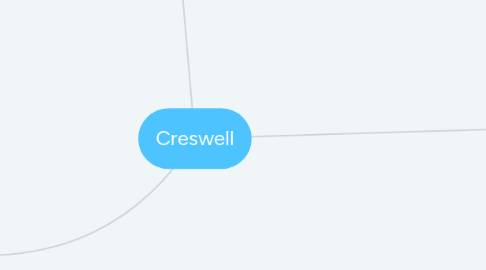
1. Topic
1.1. Central idea to explore
1.2. Choose by researcher
1.3. Describing in a few words
1.4. "My study is about"
1.5. Avoid wasting words
1.6. Include focus of study
1.7. Search for other similar studies on library
2. Theory
2.1. Variables
2.1.1. characteristics that can be observed
2.1.1.1. Temporal order
2.1.1.1.1. Procedes another in time
2.1.1.2. Their measurement
2.1.2. Order left to right
2.1.2.1. Cause and effect
2.1.3. Independent variables
2.1.3.1. Cause or affect outcomes
2.1.4. Dependent variables
2.1.4.1. results of influence of independent variables
2.1.5. Mediating variables
2.1.5.1. stand between dependent and independent variables
2.1.6. Moderating variables
2.1.6.1. find in experiments
2.1.7. Control variables
2.1.7.1. Independent variable
2.1.7.2. potentially influence dependent variable
2.1.8. Confounding variables
2.1.8.1. it's influence cannot be directly detected
2.1.9. Answer a research question
2.2. Definition
2.2.1. Set of variables
2.2.1.1. formed into hypothesis
2.2.2. Appear as
2.2.2.1. argument
2.2.2.2. discussion
2.2.2.3. rationale
2.2.3. Helps to explain or predict a phenomena
2.2.4. Provide explanation of expectation or prediction
2.2.5. Questions
2.2.5.1. Provide information about relationships
2.2.5.2. provide information about magnitud
2.2.5.2.1. Forming hypothesis
2.2.6. Breadth of coverage
2.2.6.1. Micro-level
2.2.6.1.1. Small slice of
2.2.6.2. Meso-level
2.2.6.2.1. Organizations
2.2.6.2.2. Social movements
2.2.6.2.3. Communities
2.2.6.3. Macro-level
2.2.6.3.1. social institutions
2.2.6.3.2. whole societies
2.2.7. Found in
2.2.7.1. Social science
2.2.7.1.1. psychology
2.2.7.1.2. sociology
2.2.7.1.3. anthropology
2.3. Forms of theories
2.3.1. Series of hypothesis
2.3.1.1. Interconnected
2.3.2. Logic statements
2.3.2.1. Why would expect the independent variable to influence dependent variables
2.3.3. Visual models
2.3.3.1. Visual picture
2.3.3.2. Visualize interconnection
2.3.3.3. Visualize variables
2.4. Quantitative placement
2.4.1. Uses theory deductively
2.4.2. Places at the beginning of proposal for a study
2.4.3. Theory
2.4.4. Collects data to test the theory
2.4.4.1. by examining hypothesis or questions
2.4.4.2. Contain variables
2.4.5. Acceptable definition
2.4.6. Locate an instrument
2.4.6.1. to observe participants
2.4.7. Reflects confirmation or disconfirmation
3. Literature Review
3.1. USE why/how
3.1.1. To compare results
3.1.2. To shows that students is aware of other literature
3.1.3. To provide direction for research questions or hypothesis
3.1.4. To introduce a theory
3.1.5. To introduce expected relationships
3.1.6. To explain why is useful theory
3.1.7. Seek opinion
3.1.8. Summarize the major literature
3.1.9. Develop outline
3.1.10. Develop potential references
3.1.11. Section called "Related Literature"
3.1.12. 20 to 60 pages
3.2. STEPS
3.2.1. 1. Identify key words
3.2.2. 2. Begin searching
3.2.2.1. Journals
3.2.2.2. Books
3.2.2.3. Data bases
3.2.2.3.1. ERIC
3.2.2.3.2. Google Scholar
3.2.2.3.3. Science Direct
3.2.2.3.4. ProQuest
3.2.3. 3. Locate 50 reports
3.2.4. 4. Skim initial articles
3.2.5. 5. Duplicate those central to your topic
3.2.6. 6. Begin literature map
3.2.7. 7. Draft summaries of most relevant articles
3.2.8. 8. Assemble the literature review
3.3. SELECTING
3.3.1. To stablish priority
3.3.2. 1. Broad syntheses
3.3.2.1. Literature
3.3.3. 2. Turn to journal articles
3.3.3.1. Pose a question or hypothesis
3.3.4. 3. Turn to books
3.3.5. 4. Turn to conference papers
3.3.6. 5. Turn to dessertation abstracts
3.3.7. 6. Turn to Web
3.3.7.1. Articles
3.3.7.2. Online journals
3.4. LITERATURE MAP
3.4.1. Tool to organize
3.4.2. Visual summary
3.4.3. Represented in a figure
3.4.4. Overview of existing literature
3.4.5. Structures
3.4.5.1. Hierarchical
3.4.5.1.1. Top-down presentation
3.4.5.1.2. Topic in a box
3.4.5.1.3. Levels
3.4.5.1.4. Subtopics
3.4.5.1.5. Sub-subtopics
3.4.5.1.6. Use references
3.4.5.2. Flowchart
3.4.5.3. Circles
3.5. ABSTRACTING
3.5.1. Review of literature
3.5.2. Short paragraph
3.5.3. Summarizes major elements
3.5.4. Mention the problem
3.5.5. State the central focus of study
3.5.6. Mention flaws in reasoning
3.5.7. Important information
3.5.7.1. Sample
3.5.7.2. Population
3.5.7.3. Subjects
3.6. STYLE MANUALS
3.6.1. Guidelines for style of manuscrpit
3.6.2. Use correct types of references
3.6.3. In-text references
3.6.4. End-of-text
3.6.4.1. Numbered
3.6.4.2. Alphabetized
3.6.5. Headings
3.6.6. Footnotes
3.6.6.1. At the bottom of the page
3.6.7. Tables and figures
3.7. DEFINITION OF TERMS
3.7.1. To understand a proposed research
3.7.2. Define terms
3.7.2.1. When they first appear
3.7.2.2. In all section of research
3.7.3. Include extensive definitions
3.7.4. Use accepted language
3.7.5. Separate
3.7.5.1. Call it "Definition of terms"
3.7.5.2. In separate sections
3.7.6. No more that three pages
3.8. PARAMETER
3.8.1. Write a review of literature
3.8.2. Contains sections
3.8.3. Components
3.8.3.1. Introduction
3.8.3.2. Topic 1
3.8.3.2.1. Independent variable
3.8.3.3. Topic 2
3.8.3.3.1. Dependent variable
3.8.3.4. Topic 3
3.8.3.4.1. Dependent variabe
3.8.3.4.2. Independent variable
3.8.3.5. Summary
